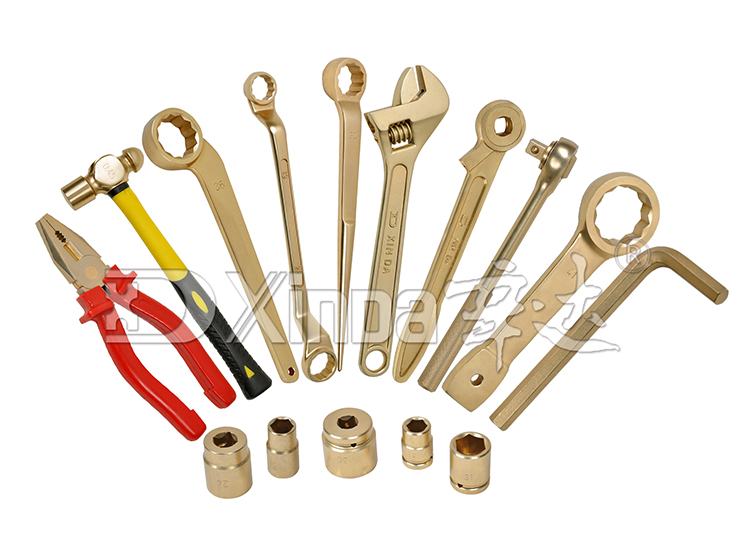Welcome to the official website of Shijiazhuang Xuda Safety Tools Co., Ltd.!
Tel:+86 15830107628
+86 13933801909
+86 0311-83221282
Fax:+86 0311-87265726
E-mail:[email protected]
Url:www.xdtools.com
Add:Xinleitou Industrial Zone, Xinji City Hebei Province,China

The following is an extract of online information for sharing.
1.Development of explosion proof tools
Explosion-proof tools have been produced abroad since the 1940s.Nowadays, in Japan, the United States, Germany, Russia and other countries, there are more and more manufacturers to produce non sparking tools.
Now China has basically changed the situations that worker has to stop production to maintenance and operate venturesomely without explosion proof tools.Combining with the formulation of national standards for non sparking tools,the detection of non-denotion performance for copper alloy materials used in explosion proof tools has been carried out.Testing centers have been finished.With the improvement of these tasks, the performance and quality of explosion-proof products will be further improved, and the export of explosion-proof tools can be used widely in varierious industries.
2.Mechanism of explosion-proof tools
1.1.Does not contain carbon. No oxygen-iron-carbon reaction chain, so no spark
1.2.The strength and hardness of copper are relatively low, and the thermal conductivity is higher than that of steel. When friction or impact occurs, local friction points will be plastically deformed to avoid friction energy concentrated on individual points. In addition, the material's high thermal conductivity,the heat generated by friction is quickly dissipated to the substrate to reduce the risk of hot and high temperatures at the point of frictional impact.
However, the strength and hardness of pure copper is too low to be directly used as a tool, and appropriate metal elements such as beryllium, aluminum, titanium, and nickel need to be added to smelt into a copper alloy to increase its strength and hardness.
At present, various copper-based alloys such as beryllium bronze, aluminum bronze, and J892 copper alloy have been successfully used in explosion-proof tools in the industry.
3.Performance of explosion proof tools
3.1,Aluminum bronze,Al-Cu,aluminum,nickel,manganese,iron and other metals were added to the high purity electrolytic copper as matrix to form copper-based alloy.
Suitable for ethylene with concentration below 7.8%,standard code GBEX ⅡB
Hardness is not less than HRC25,Tensile strength δ b 75-85kgf/mm2
3.2,Beryllium copper,Be-Cu,the copper base alloy was forming by adding some metals such as beryllium,nickel.
The thermal and electrical conductivity of these two materials are very good,beryllium bronze is non-magnetic and can be used in strong magnetic fields.
Suitable for hydrogen with concentration below 21%,standard code GBEX ⅡC
Hardness is not less than HRC35,Tensile strength δ b 105-120kgf/mm2
When these two copper alloys are subjected to high-speed impact or friction, their mechanical energy is converted into thermal energy when they are applied to the surface of the object, and the surface temperature suddenly rises. However, due to the high electrical conductivity and thermal conductivity of the material, the heat on the work surface is quickly transferred to other parts of the workpiece, and the heat on the work surface is drastically reduced. Some particles detached from the workpiece under impact or friction do not reach the temperature of the ignition source.Copper alloy intermetallic compounds are relatively stable, have high melting points, and are not easy to violently oxidize.During high-speed impact or friction, although the temperature of the applied surface or some of the detached particles has risen, none of them can react violently with oxygen and other flammable gases, it can not form an ignition source.
4.Applications of explosion proof tools
Petroleum refining and petrochemical industry, coal mine, oil field, natural gas chemical industry, gunpowder industry, chemical fiber industry, paint industry, fertilizer industry, various pharmaceutical industries. Oil tankers and LPG vehicles, airplanes, warehouses operating flammable and explosive products, electrolytic workshops, telecommunication machine assembly workshops, places that require tools not rusty, wear-resistant and anti-magnetic
5.Attentions of Explosion-proof Tools
In the following two cases, the spark that detonates is not generated by the explosion-proof tool itself, but by the work object. The application of non sparking tools cannot avoid this explosion, but other explosion-proof methods must be used.
1.When a tool collides with a rock, it is possible to generate a spark. In this case, the generation of the spark has nothing to do with the metal. When the rock ruptures by the rising force, the mechanical energy of the impact becomes electrical energy.This electrical energy is released in the form of electric sparks. Sparks are particularly easy to produce in rocks containing quartz, silica, and sandstone.Generally speaking, the higher the content of quartz, or the larger the particles, the easier it is to ignite. In order to prevent an explosion accident, rocks can be intruded into the water and exploded.
2.When an explosion-proof tool is used to strike or rub a copper-iron hot workpiece coated with aluminum paint, it is possible to generate sparks that can ignite explosive substances.If the particles of aluminum, magnesium and their alloys are slightly adhered to the rusted steel surface.A hard exothermic "aluminum reaction" may occur when struck by hard substances or even hard rubber or plastic, which is likely to detonate.
6.Maintenance of explosion proof tools
1.Remove oil on the surface of various products before use.
2.Remove dirt and deposits on the surface after use and store in a dry and safe place.
3.Striking tools should not be used continuously. There should be an appropriate interval more than ten times and the detritus on the product should be removed in time before continuing to use.
4.Wrenches are not allowed to be used with excessive force, nor can they be extended by using sleeves or other metal rods to extend the arm, or by hammering (except for striking wrenches) to turn fasteners.
5.Cutting edge tools should be placed in the water tank to lightly touch the grinding wheel for sharpening. Do not use excessive force and contact the grinding wheel for a long time.
6.In the actual operation of the striking tools, it is necessary to remove the debris on the site and the corroded oxide on the working surface in case of third party striking.
